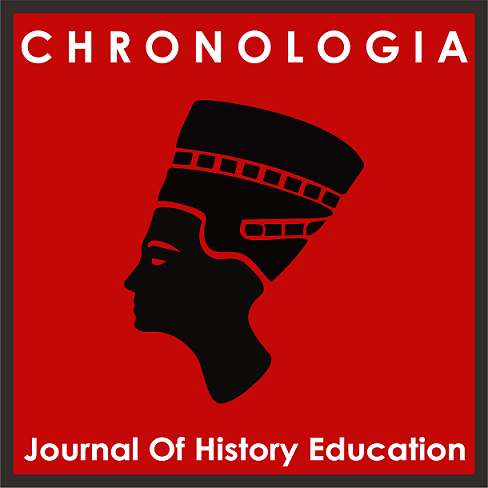Main Article Content
Abstract
The implementation of the forced cultivation policy in the Dutch East Indies has provided significant changes such as the transition of transportation facilities. This spearheaded the development of railways on the island of Java, one of which was the creation of the Semarang-Juwana railway line built by the Semarang-Joana Stoomtram Maatchappij (SJS) company. So this study aims to analyze the history and development of the Semarang-Juwana railway line built by the Semarang-Joana Stoomtram Maatschappij (SJS) company. This research uses a historical method consisting of four steps, namely heuristics, source criticism, interpretation and historiography. The results showed that the presence of the Semarang-Juwana line has also indirectly had an impact on the growth of the area around the train line which is characterized by increasing community mobility and increasing the pace of economic activity of indigenous peoples.
Keywords
Article Details

This work is licensed under a Creative Commons Attribution 4.0 International License.
References
- Daliman. (2012). Metode Penelitian Sejarah. Yogyakarta: Ombak.
- Hermawan, I. (2014). Kereta Api Mengurai Kebuntuan Transportasi di Pulau Jawa. Prosiding Seminar Nasional Arkeologi 2014: “Kesatuan Dalam Keberagaman.” Bandung: Balai Arkeologi Bandung.
- Hermawan, I. (2018). Kereta Api: Kuasa Ekonomi Masa Kolonial Belanda. Prosiding Seminar Nasional Arkeologi, 87–94.
- Kusuma, R., & Purnomo, A. (2018). Sejarah Kereta Api Rute Semarang-Rembang Tahun 1967-1988. Journal of Indonesian History, 7(1), 56–61.
- L.M.F. Purwanto. (2005). Kota Kolonial Lama (Tinjauan Umum Sejarah Perkembangan Arsitektur Kota). DIMENSI (Jurnal Teknik Arsitektur), 33(1), 27–33.
- Lombard, D. (2008). Nusa Jawa: Silang Budaya Jilid 1. Jakarta: Gramedia Pustaka Utama.
- Mulyana, A. (2017). Sejarah Kereta Api di Priangan. Yogyakarta: Ombak.
- Ratnawati, Y. (2015). Perkembangan Perkeretaapian Pada Masa Kolonial Di Semarang Tahun 1867-1901. Journal of Indonesian History, 3(2), 65–69.
- Rizaldi, A. (2019). Dinamika Perkeretaapian Lintas Semarang-Juwana Tahun 1950-1998. Skripsi: Universitas Diponegoro, 1(1), 1–10.
- Saraswati, R. S., & LMF Purwanto. (2022). Jejak Sejarah Trem Kota Semarang 1881-1840. Jurnal Arsitektur Kolaborasi, 2(1), 10–17. https://doi.org/10.54325/kolaborasi.v2i1.17
- Syahabuddin, A. (2019). Samarang-Joana Stoomtram Maatschappij (SJS): Jalur Semarang Juwana Tahun 1881-1910. Ilmu Sejarah, 206–220.
- Yuliati, D. (2009). Menuju Kota Industri, Semarang pada Era Kolonial. Semarang: Badan Penerbit Universitas Diponegoro.
- Yuliati, D. (2019). Mengungkap Sejarah Kota Lama Semarang dan Pengembangannya Sebagai Asset Pariwisata Budaya. Anuva: Jurnal Kajian Budaya, Perpustakaan, Dan Informasi, 3(2), 157–171. https://doi.org/10.14710/anuva.3.2.157-171
References
Daliman. (2012). Metode Penelitian Sejarah. Yogyakarta: Ombak.
Hermawan, I. (2014). Kereta Api Mengurai Kebuntuan Transportasi di Pulau Jawa. Prosiding Seminar Nasional Arkeologi 2014: “Kesatuan Dalam Keberagaman.” Bandung: Balai Arkeologi Bandung.
Hermawan, I. (2018). Kereta Api: Kuasa Ekonomi Masa Kolonial Belanda. Prosiding Seminar Nasional Arkeologi, 87–94.
Kusuma, R., & Purnomo, A. (2018). Sejarah Kereta Api Rute Semarang-Rembang Tahun 1967-1988. Journal of Indonesian History, 7(1), 56–61.
L.M.F. Purwanto. (2005). Kota Kolonial Lama (Tinjauan Umum Sejarah Perkembangan Arsitektur Kota). DIMENSI (Jurnal Teknik Arsitektur), 33(1), 27–33.
Lombard, D. (2008). Nusa Jawa: Silang Budaya Jilid 1. Jakarta: Gramedia Pustaka Utama.
Mulyana, A. (2017). Sejarah Kereta Api di Priangan. Yogyakarta: Ombak.
Ratnawati, Y. (2015). Perkembangan Perkeretaapian Pada Masa Kolonial Di Semarang Tahun 1867-1901. Journal of Indonesian History, 3(2), 65–69.
Rizaldi, A. (2019). Dinamika Perkeretaapian Lintas Semarang-Juwana Tahun 1950-1998. Skripsi: Universitas Diponegoro, 1(1), 1–10.
Saraswati, R. S., & LMF Purwanto. (2022). Jejak Sejarah Trem Kota Semarang 1881-1840. Jurnal Arsitektur Kolaborasi, 2(1), 10–17. https://doi.org/10.54325/kolaborasi.v2i1.17
Syahabuddin, A. (2019). Samarang-Joana Stoomtram Maatschappij (SJS): Jalur Semarang Juwana Tahun 1881-1910. Ilmu Sejarah, 206–220.
Yuliati, D. (2009). Menuju Kota Industri, Semarang pada Era Kolonial. Semarang: Badan Penerbit Universitas Diponegoro.
Yuliati, D. (2019). Mengungkap Sejarah Kota Lama Semarang dan Pengembangannya Sebagai Asset Pariwisata Budaya. Anuva: Jurnal Kajian Budaya, Perpustakaan, Dan Informasi, 3(2), 157–171. https://doi.org/10.14710/anuva.3.2.157-171

